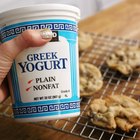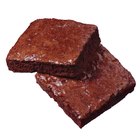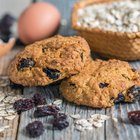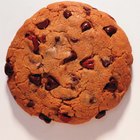
Every baker has a preference when it comes to cookies. Some like them small and crisp, others favor big and chewy. To some extent, these preferences determine your choice of ingredients. Fundamental decisions such as the kind of sugar you use, or whether you make your cookies with butter or shortening, make a big difference to the cookies' final texture and flavor.
Cookies
Cookies come in a wide range of shapes, sizes and textures, but most are based on a relatively small handful of ingredients. These basics include flour, eggs, fat, sugar and flavorings. Depending how these ingredients are combined, the resulting cookies can be crisp, chewy or soft and cakelike. Flavorings and additives like cinnamon, raisins, nuts or chocolate chips make an obvious difference in the cookies' flavor, but changing the fat renders a subtler difference.
The Role of Fat
Creaming the fat and sugar together, to create tiny air pockets, is how cookies become light. Later, during the baking process, baking powder or soda will inflate those tiny air pockets by producing carbon dioxide. Any fat that's solid at room temperature can be used to make cookies, but some are better than others. Lard and beef fat are too heavy for most cookies, and bacon fat too strongly flavored. Edna Stabler's cookbook "Food that Really Schmecks" notes that among her area's old-timers, chicken fat was said to make the crispiest cookies. Shortening, margarine and butter are more common choices.
Shortening vs. Butter
If you're accustomed to making your cookies with shortening, switching to butter will change the outcome slightly because butter is only about 80 percent fat, with the remaining volume made up of water and milk solids. Cookies made with butter will spread more, because of its lower melting point. Shortening makes crisp cookies crisper, while butter gives them a slightly softer crumb. Butter is better for chewy cookies, which require more moisture and less fat. The same holds true for soft, cakey cookies. If you're making large batches, use more butter and less liquid than if you'd used shortening.
Health Considerations
Health-conscious bakers often use shortening or margarine in place of butter, because of butter's high percentage of saturated fats. Unfortunately, shortening and margarine usually contain hydrogenated oils and trans-fats, which can be even more harmful than saturated fats. According to the University of Maryland Medical Center, trans-fats not only increase bad LDL cholesterol, they deplete good HDL cholesterol. As trans-fats are phased out for health reasons, non-hydrogenated shortening and margarine will become more widely available. In the interim, butter is at least as healthy as hydrogenated fat, and better tasting.
Related Articles

Canola Oil Vs. Lard in Baking

How to Replace Butter With Greek Yogurt ...
How to Substitute Applesauce for Butter ...

Calories in Dark Chocolate Truffles

Can Humidity Affect Cookies?

Substitute for 1 Square of Baking ...

Can I Put Butter in Brownie Mix Instead ...

Butter Substitute for Baking Scones

Can You Use Butter Instead of Cooking ...

How to Substitute Applesauce for Oil in ...

What Can I Substitute Unsalted Butter ...

Substitutes for Butter When Baking ...

How to Replace Yogurt for Butter in ...

Oatmeal Raisin Cookies Without Baking ...

Can You Make a Boxed Cake Without ...

Is Butter or Shortening Better for Soft ...

What Is the Highest Quality Butter for ...

Can You Make Tiramisu With Margherite ...

How to Substitute Margarine for Butter ...

Butter Substitute for Molten Lava Cake
References
- "On Food and Cooking: The Science and Lore of the Kitchen"; Harold McGee; 2004
- "The Professional Pastry Chef"; Bo Friberg; 2002
- "Professional Cooking"; Wayne Gisslen; 2003
- University of Maryland Medical Center: Trans-Fats 101
- "Food That Really Schmecks: Mennonite Country Cooking"; Edna Staebler; 1968
Writer Bio
Fred Decker is a trained chef and prolific freelance writer. In previous careers, he sold insurance and mutual funds, and was a longtime retailer. He was educated at Memorial University of Newfoundland and the Northern Alberta Institute of Technology. His articles have appeared on numerous home and garden sites including GoneOutdoors, TheNest and eHow.
Photo Credits
Thomas Northcut/Digital Vision/Getty Images